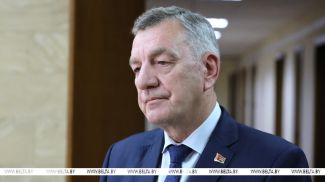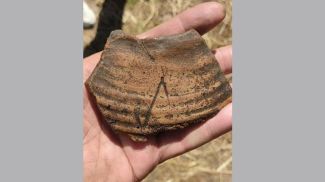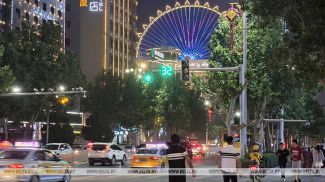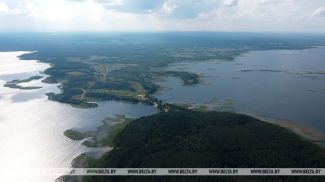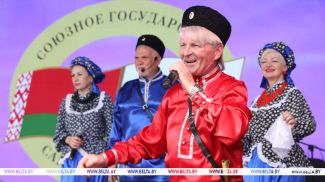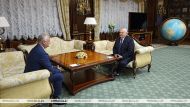BREST, 28 March (BelTA) – The cross-border standing committee that will deal with the restoration of the Dnieper-Vistula waterway was established during the two-day international conference on the restoration of the water transportation between the Baltic Sea and the Black Sea that is taking place in Brest on 27-28 March, BelTA has learnt.
The participants of the conference passed the declaration to support the project "Restoration of the E40 waterway on the Dnieper-Vistula section: from strategy to planning". The tripartite standing committee, the secretariat and working groups were set up. The procedural rules of the committee were adopted. These rules will regulate the work of the commission and its interaction with project partners. This will create the necessary conditions to translate the project from theory to practice.
Deputy Transport and Communications Minister of Belarus Alexander Shishko noted: “We have made our first step today. The further success will depend on our determination to reach our goal. If our partners, our neighbors join the project, this waterway will be restored. There is no doubt that the project will benefit Belarus, Ukraine and Poland, as the project aims to promote not only the waterway itself, but also the entire infrastructure around it”.
The project to restore the E-40 waterway on the Dnieper-Vistula section is based on the findings of international experts. This project will give Poland, Belarus, and Ukraine an opportunity to become centers of international multimodal transportation, will allow reducing traffic on roads, reducing carbon dioxide emissions, fulfilling the tourism potential of the Dnieper-Bug waterway. Belarus will get access to the Baltic Sea ports, while the water routes of Belarus will be included into network of internal waterways of Western Europe.
The international technical aid project "Restoration of the E40 waterway on the Dnieper-Vistula section: from strategy to planning" is funded by the European Union within the framework of the cross border cooperation program Poland-Belarus-Ukraine 2007-2013. The total cost of the project is over €900,000. “This is a long-standing and expensive project, just like any project related to domestic and international water transportation. We should not expect a fast payoff after the project is implemented. However, the European Commission is ready to invest, because the project is very interesting. The section of the waterway that connects Poland, Belarus and Ukraine is the missing link between Western Europe and Eastern Europe,” Martina-Sophie Fouvez, Regional Adviser of the Transport Division of the United Nations Economic Commission for Europe said.
During the first day of the conference experts from the three countries presented their reports on the E-40 waterway and its development prospects. The participants of the conference also toured infrastructure facilities of the Dnieper-Bug waterway, in particular, renovated waterworks near Brest. On 28 March the working groups will discuss the objectives of the feasibility study of the project.
Taking part in the conference are representatives of transport, infrastructure and development ministries, nature and environmental protection ministries, water management agencies, regional and local authorities, research centers, and public associations of Belarus, Poland, and Ukraine.
The water route E-40 connects the basins of the Baltic Sea and the Black Sea. However, at present only the Brest-Kherson section of this route is used, because the section from Brest to Warsaw along the Western Bug River is not navigable. The total length of the waterway is more than 2,000km, of which 626km go through Belarus.
The participants of the conference passed the declaration to support the project "Restoration of the E40 waterway on the Dnieper-Vistula section: from strategy to planning". The tripartite standing committee, the secretariat and working groups were set up. The procedural rules of the committee were adopted. These rules will regulate the work of the commission and its interaction with project partners. This will create the necessary conditions to translate the project from theory to practice.
Deputy Transport and Communications Minister of Belarus Alexander Shishko noted: “We have made our first step today. The further success will depend on our determination to reach our goal. If our partners, our neighbors join the project, this waterway will be restored. There is no doubt that the project will benefit Belarus, Ukraine and Poland, as the project aims to promote not only the waterway itself, but also the entire infrastructure around it”.
The project to restore the E-40 waterway on the Dnieper-Vistula section is based on the findings of international experts. This project will give Poland, Belarus, and Ukraine an opportunity to become centers of international multimodal transportation, will allow reducing traffic on roads, reducing carbon dioxide emissions, fulfilling the tourism potential of the Dnieper-Bug waterway. Belarus will get access to the Baltic Sea ports, while the water routes of Belarus will be included into network of internal waterways of Western Europe.
The international technical aid project "Restoration of the E40 waterway on the Dnieper-Vistula section: from strategy to planning" is funded by the European Union within the framework of the cross border cooperation program Poland-Belarus-Ukraine 2007-2013. The total cost of the project is over €900,000. “This is a long-standing and expensive project, just like any project related to domestic and international water transportation. We should not expect a fast payoff after the project is implemented. However, the European Commission is ready to invest, because the project is very interesting. The section of the waterway that connects Poland, Belarus and Ukraine is the missing link between Western Europe and Eastern Europe,” Martina-Sophie Fouvez, Regional Adviser of the Transport Division of the United Nations Economic Commission for Europe said.
During the first day of the conference experts from the three countries presented their reports on the E-40 waterway and its development prospects. The participants of the conference also toured infrastructure facilities of the Dnieper-Bug waterway, in particular, renovated waterworks near Brest. On 28 March the working groups will discuss the objectives of the feasibility study of the project.
Taking part in the conference are representatives of transport, infrastructure and development ministries, nature and environmental protection ministries, water management agencies, regional and local authorities, research centers, and public associations of Belarus, Poland, and Ukraine.
The water route E-40 connects the basins of the Baltic Sea and the Black Sea. However, at present only the Brest-Kherson section of this route is used, because the section from Brest to Warsaw along the Western Bug River is not navigable. The total length of the waterway is more than 2,000km, of which 626km go through Belarus.




